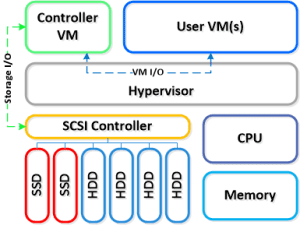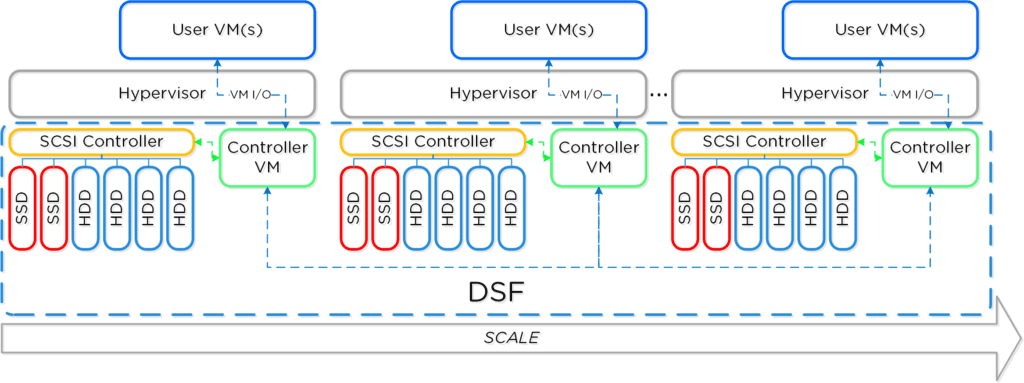To continue NPP training series here is my next topic: Cluster Architecture
To give credit, some of this content was taken from Steve Poitras’s “Nutanix Bible” blog as his content is the most accurate and then I put a Hyper-V lean to it.
Cluster Architecture
The Nutanix solution is a converged storage + compute solution which leverages local components and creates a distributed platform for virtualization aka virtual computing platform. The solution is a bundled hardware + software appliance which houses 2 (6000/7000 series) or 4 nodes (1000/2000/3000/3050 series) in a 2U footprint. Each node runs an industry standard hypervisor (ESXi, KVM, Hyper-V currently) and the Nutanix Controller VM (CVM). The Nutanix CVM is what runs the Nutanix software and serves all of the I/O operations for the hypervisor and all VMs running on that host. For the Nutanix units running VMware vSphere, the SCSI controller, which manages the SSD and HDD devices, is directly passed to the CVM leveraging VM-Direct Path (Intel VT-d). In the case of Hyper-V the storage devices are passed through to the CVM. Below is an example of what a typical node logically looks like:

Together, a group of Nutanix Nodes forms a distributed platform called the Distributed Storage Fabric (DFS). DFS appears to the Hyper-V like any centralized storage array, however all of the I/Os are handled locally to provide the highest performance. More detail on how these nodes form a distributed system can be found below. Below is an example of how these Nutanix nodes form NDFS and then presented up to Hyper-V via SMB 3.0 Share(s):
DFS uses a software-defined, shared-nothing, scale-out approach to storage that eliminates the need for you to deploy a separate SAN along with its performance bottlenecks and scalability limitations. DFS leverages local SSD for fast VM performance and consolidates high capacity HDDs for cost-effective storage capacity.
The application data is intelligently placed in the appropriate storage tier, balancing storage performance and capacity needs. The environment’s noisy VMs on different hosts won’t impact the performance for any workloads—fulfilling key performance requirements for hybrid deployments.
Here are the key points with Hyper-V on Nutanix:
- Hypervisor sees the Distributed Storage Fabric (DFS) as one or more SMB 3.0 file shares
- Supports features like snapshots, dedupe, compression web-scale out, and disaster recovery
- Locally shared storage is comprised of both flash and spinning disks
- Variety of models (compute heavy, storage heavy, etc.)
- Mix and match models within the same cluster
- Pay as you grow – Start small and linearly scale your Microsoft infrastructure in minutes without the scalability shortcomings of traditional servers and storage.
Next up in the NPP Training series – Cluster Components

